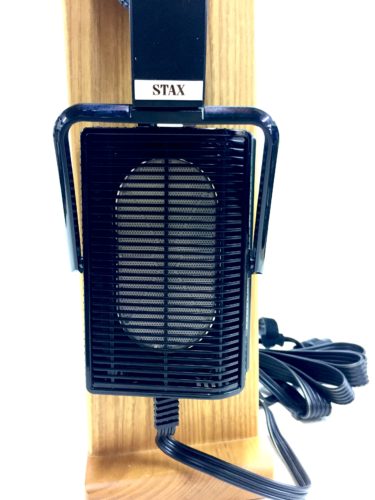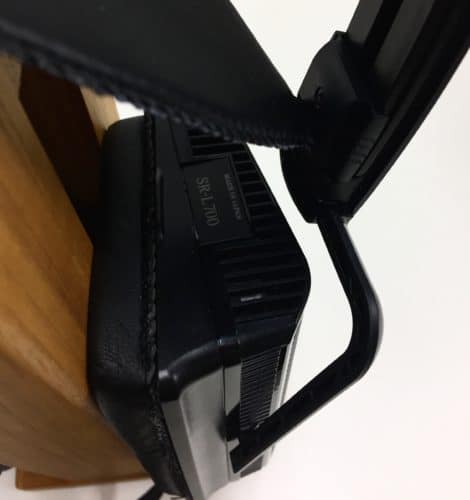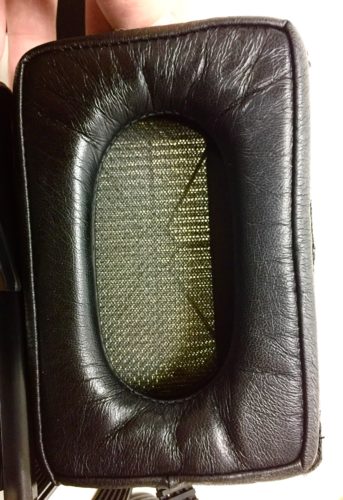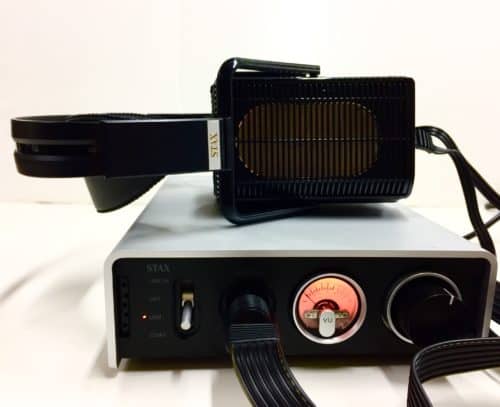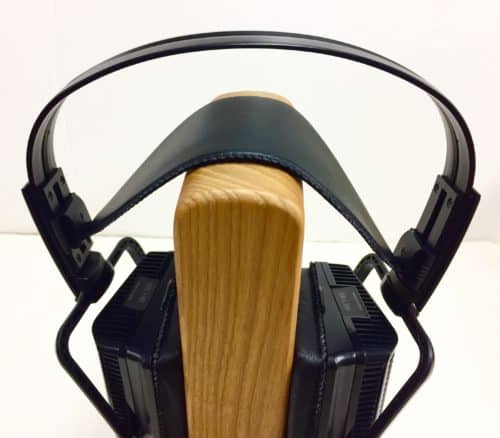It’s unfortunate that, until now, us MajorHifi editors haven’t had Stax on our desks. The Stax SR-L700 has always been one of the headphones I’ve most wanted to hear, and at CanJam 2020, I finally got the chance. Put simply, I was blown away. And after talking with Stax’s own Douglas Ip, he was kind enough to send a couple demo units to MajorHifi to review. Score!
For the unfamiliar, Stax has been manufacturing electrostatic headphones, or “earspeakers,” as they like to call them, for decades now. Electrostatic headphones (hereinafter referred to as “electrostats”) use pure electricity to move the driver and produce sound – no magnets involved. I won’t bother explaining the principle in its entirety here, since I barely understand it myself. The important thing to remember? The absence of magnets allows the drivers of electrostats to be incredibly light and thus incredibly fast.
Back when Stax began making their first headphones, releasing the SR-1 in 1960, they just completely destroyed the competition – nobody was making things that sounded anything like that. And today, the SR-1 supposedly still sounds better than a lot of headphones out there.
These days, Stax is no longer head and shoulders above the competition, having gained some significant rivals. For example, companies like Focal and Sennheiser have made dynamic-driver-based headphones that rival Stax in detail retrieval. But, make no mistake: Stax still makes some of the best headphones around, including the $1200-$1500 SR-L700.
Build and Appearance
If I could find one word to describe the appearance of the SR-L700, it might be…unapologetic?
Well, let’s get down to brass tacks. These things look absolutely ridiculous. Stax hasn’t made many visual changes to the Lambda lineup, of which the L700 is the latest incarnation, since 1979. And with the SR-L700, that fact is manifestly obvious. They’re rectangular, and the outside of the earcup is essentially just a plastic cage. The headband is also really tall, suspended high above the head, no matter the listener’s head size.
No, I don’t expect anybody who owns any Lambda to take it outside the house, so I don’t think the appearance much matters. Personally, I like the way they look. The driver’s stator, visible through the plastic cage, looks elegant and well-constructed, and the whole thing has a kind of retro look, hearkening back to the long-lost Age of Plastic.
Yes, for those who care, these are made of plastic. Perhaps that’s simply because they would be too heavy if they were made out of metal, which I could believe. I’ve heard stories of older Lambdas’ headbands breaking, though I’ve heard no such stories about the L700, which has an updated headband. But I respect Stax’s decision to retain their older design for their newer products; after all, the Lambda line is a sort of institution of its own at this point.
The review unit we received was the first version of the L700. We’ve now passed on to the Mk2 version, which adds a detachable cable – if you buy them today, you’ll probably get the Mk2. Stax’s website doesn’t mention any sonic changes, so I’m pretty sure it’s mostly the cables. You can consult their website for other changes.
Comfort
One would expect the Stax SR-L700’s light weight and large earcups to make it a pretty comfortable wear. And one would be right. The SR-L700 is among one of the more comfy headphones that I’ve worn, right up there with Hifiman (whose headphones had previously held the title for me). It possesses a great combination of a suspension headband that conforms well to my head shape, very light clamping force, and soft, spacious earpads.
Adjusting the suspension headband is easy and natural, with an intuitive clicking system. Not much more to say there – it works well.
As far as critiques go, I do find them to sit a bit loosely on my head, and shaking my head around does cause them to move around a bit. It’s not egregious, but I wouldn’t take these jogging, and I can imagine that they may be a bit too loose to listen to music in bed, if that’s what you’re into.
Sound
The Stax SR-L700 can go anywhere from $1200 to $1600, depending on who your seller is. That’s a fair amount of money – so does the L700 sound “worth it?”
I find that it does. Many people characterize the Stax sound as one of “effortlessness,” as if the drivers can pull detail out of the music without really trying. Listening to the L700, I find it hard not to agree with that assessment. Besides a slightly uneven frequency response (I’ll get to that later), it’s tough to find a single unquestionable flaw with the sound of these headphones.
Yet I know some people who dislike the sound of Stax, and I can understand that perspective too. There’s a certain weightlessness to the sound of the Lambda series – not a lack of body so much as a kind of misty artificiality that you only really “get” when you listen to them for a while, with a wide variety of different music. Let’s just say that with classical and ambient these sound perfectly realistic, but with heavier or more driving music they may not completely convince.
Just so you know, I was testing the L700 with the Stax SRM-D50 DAC/amp. Newcomers to electrostats should take note: you can’t run these off normal amps. Only special electrostat-specific amps will do, due to the special way that these headphones operate.
Bass
Look at a frequency-response graph, and the Stax SR-L700 looks rather strange, with a slight midbass hump at 70-80Hz and a sharp rolloff below that. Given the roll-off, one would expect the L700 to have rather weak bass. In practice, I find that the L700’s bass is fine, tight, very well-articulated, but not exceptionally powerful.
It has very low distortion, and it’s not boomy or muddy in the slightest, but it lacks the kind of punch that a good dynamic driver would deliver. Anyone looking for exceptional bass slam should look at dynamics or planars in lieu of electrostats. It’s said sometimes that with the Lambdas, you can hear the bass but not feel it. I think that’s a bit of an exaggeration. I had moments where I was satisfied with the power of the L700’s bass. But these certainly aren’t for bassheads.
Mids
The SR-L700’s midrange is not neutral, but it’s well-balanced and pleasant. Some people have noticed a rather annoying shout at around 1.5kHz. While this shout is certainly audible, I don’t find it very annoying – certainly not as in-your-face as on some headphones from AKG, Grado, Audio-Technica, etc. (which I very much like). Still, it throws the timbre just a tiny bit off.
The overall tone is ever-so-slightly warm and relaxed, with that 1.5kHz boost adding a little bit of “presence.” The upper mids are somewhat laid-back compared to the lower mids, giving the L700 a wide, spacious sound.
Of course, the L700’s drivers are incredibly fast, and the midrange is no exception: there is no mud, no lack of clarity. Everything is perfectly clear and audible. That’s one of the major strengths of the electrostatic driver. The downside is that these are a bit reluctant to “rock,” so to speak. Those looking for a hard-hitting, aggressive midrange will want to look elsewhere – I think many of the people who dislike the L700 are looking for a slightly slower, more natural decay. I can understand that; I’d still take some of my other headphones for rock music.
Treble
Although I don’t always rush to take issue with slightly botched treble, I also have yet to find a headphone with treble that I’d call perfect.
Well, the L700’s treble is very close to perfect. The frequency response is not 100% even – there might be a very small bump at around 10kHz – but there’s no glare, no harshness, no roll-off, no ringing. One gets a very good sense of air and detail without the feeling that it’s being forced into your ears. There is no etch. There is almost no sibilance. Even harsher-sounding recordings take on the sort of soft sound for which Stax is known – it’s a borderline magical experience. But you won’t miss a single thing happening in the treble with your recordings.
Soundstage
As I’ve said, the SR-L700 has a very airy, lifelike presentation – but does it have a wide soundstage? Yes, of course it does! One of the biggest advantages to the “Stax sound” is that you can’t quite tell where the sound is coming from, owing to the incredibly fast driver, and that translates to a wide-sounding soundstage.
That said, the imaging isn’t quite as precise as, say, an HD800. There’s a little bit of a lack of specificity, especially in the center image, and the stage is a little wider than it is deep, especially right in the center. That said, that only becomes obvious when compared to the very best – and the HD800 probably has the best soundstage of any headphone I’ve tried. So we can say that the L700 is close to the best, but not quite.
In Conclusion
The Stax SR-L700 offers supreme detail and a type of diffuse, airy, almost inscrutable presentation that you won’t find anywhere else. Where the L700 lacks is in tactility or a sense of “feeling” the instruments – it has a sort of ethereal timbre that can be bothersome to some people. But, without a doubt, the Stax sound is the kind of thing anyone who likes audio should try at least once in their life. The level of detail is extreme, and the natural and smooth presentation of sounds is addictive.
In fact, I was impressed enough by the SR-L700 to go out and buy a pair of Stax almost immediately after hearing them.
At around $1500, the SR-L700 isn’t cheap. But for those who enjoy classical music or ambient, I’d consider it well worth the price of admission. Bravo, Stax!
https://majorhifi.com/stax-sr-l700-review-or-what-is-the-stax-sound/

